s TAT e M e NT



When state investment in higher education falls behind the needs of our public colleges and universities, it is inevitable that the burden falls squarely on the backs of our students in the form of higher tuition and fees. The result is future debt through increased student loans.
It may surprise you to know that Massachusetts—which has long been considered a national leader in education— currently ranks 48th in the country in state spending on higher education as a percent of personal income. Only six other states have cut higher education spending at a higher rate than Massachusetts between 2001 and 2013.
Economic prosperity is the key to a healthy commonwealth. If we are to continue providing the skilled and well-educated work force that tomorrow will require, we must seek creative and innovative ways to see our youth through to graduation—and a future—despite these barriers. Within the pages of this magazine, you will learn more about the quality educators we are producing for the region—teachers who have helped make K-12 public education in Massachusetts number one in the nation.
Kim Gassett-Schiller ’83 and Henry Bertolon ’74 understand the struggles our students face in their pursuit of a degree. As co-chairs of the university’s 10,000 Reasons campaign they are spearheading the effort to provide more students with an opportunity to attend college. “On the whole,” they say, “our students have overcome more obstacles than most on their way to a bachelor’s degree. Many are first-generation college students, Pell grant recipients, veterans, or working parents.”
They, and every alumnus, faculty member, employee, student, trustee, parent, and friend of this great university who has donated to this critically important campaign, understand that to curtail the rising costs of higher education that threaten our students most in need, we must all find our reason and solidify it with our support.
editor
James K. Glynn ’77
design and production
Simeen Brown
assistant editors
Taylor Mugford
Margo W.R. Steiner ’11G
copy editors
Patrice (Bonin) Buchanan ’75
photography
Scott Booth
Simeen Brown
David Sokol
Sperlinginteractive.com

Margo W.R. Steiner ’11G
writing
Joe Beitz
Sabrina Baumann’16
v ictor DeRubeis
Karen Gahagan
James K. Glynn ’77
Stefanie howlett
Taylor Mugford
Brion O’Connor
Allan Shwedel
Margo W.R. Steiner ’11G

Kelly Tanner ’17
Stephen young
editorial advisory board
Donna Beaulieu
Rob Brown
Patrice Buchanan
Karen Murray Cady
linda Coleman
Mary Dunn ’78
Taylor Mugford
Kathleen Neville
Anthony Pira ’13G
Mandy Ray
Margo Steiner ’11G
Tom Torello
t: 978.542.7519
e: statement@salemstate.edu
w: salemstate.edu/statement
Salem State University publishes Salem Statement twice a year.
Copyright 2015 Salem State University
All publication rights reserved. Send address changes to Alumni Affairs
Sincerely,
Patricia Maguire Meservey Presidenta: 352 l afayette Street
Salem, MA 01970
e: alumni@salemstate.edu
t: 978.542.7552
on the cover Students at the Paul Revere Innovation School in Revere .
Photograph by David sokol
Well, quite a bit. So much, in fact, that we decided to dedicate the winter edition to the subject. I hope you enjoyed the “What’s New” issue of the Statement which reported on the ongoing campus renaissance.
Here we are six months later, turning our attention to something not so new, the university’s role in K-12 public schools. A national education magazine recently concluded that Massachusetts, with a solid B, has the best public schools in the country. So, we turn our attention to the discipline upon which Salem State was founded–education. We turn to our alumni, 28 percent of whom have education degrees, to our professors and to our students to explain why Massachusetts schools are performing so well. To get right to the bottom of it, our writer visited the Paul Revere Innovation School in Revere and sat in on lessons being taught by Salem State students, both graduate and undergraduate. His observations send a clear message: Salem State is a reason.
Our report explores what the university is doing to help K-12 public schools improve their overall grade, and finds that it won’t relax until Massachusetts earns an A.
It was a D- that had an effect on me when I was a Salem State sophomore taking Professor Kirkpatrick’s English literature class in the 70s. Kirkpatrick’s mid-term essay exam asked questions relating to the works of Chaucer. It was open book, but who needed one? I eagerly filled the pages of the blue exam book with my class notes, thinking all the while how Kirkpatrick wasn’t so tough after all.
I was thinking a possible A- but at least a B+.
D-! “Reiteration of class notes,” the professor wrote.
OK. I got it. A second chance came during the finals. This time I expressed my interpretations of the literature instead of the professor’s. When he handed back the graded essays, he took a moment to look me in the eye. “It was good,” he said.
I flipped to the inside of the blue book. B-!
Yes! It was a transformational moment, one that got me thinking differently and more confidently. The B that Massachusetts schools scored on the study conducted by Education Week is better than my D-, but it has had the same effect. It has the schools striving to do better, to go for the A.
—Jim Glynn ’77, editor, Salem Statement
The Rotary Club of Salem, Virginia, selected women’s basketball guard Rachael Carter as one of 10 finalists for its prestigious Jostens Trophy. The national award recognizes outstanding men’s and women’s National Collegiate Athletic Association (NCAA) Division III players, taking into account basketball ability, academic prowess and community service. The trophy models the Rotary International motto of “Service Above Self” by recognizing those who fit the ideal of a well-rounded NCAA Division III student-athlete.
Carter, a senior nursing major with a 3.40 grade-point average, participates in many community services. A volunteer with Special Olympics, she has assisted with the planning and implementation of basketball drills during a half-day sports clinic and served as a “buddy” to a Special Olympics athlete for a day. She is also a volunteer referee and coach for Salem State’s annual Special Olympics basketball tournament. Additionally, Carter has served as a mentor with Girls Inc. of Lynn, and with the annual National Girls and Women in Sports Day event held in February. A member of the All-Massachusetts State Collegiate Athletic Conference (MASCAC) first team, this year she concluded her career as Salem State’s second all-time leading scorer with 1,719 points. A four-time MASCAC player of the week, she also received recognition twice as the New England Women’s Basketball Player of the Week and was an Eastern Collegiate Athletic Conference co-player of the week selection. The Merrimack, N.H. native led the MASCAC in scoring with 19.4 points per game and was second in rebounding, with 10.9 boards per game, while leading the MASCAC with 17 double-doubles. n

Alumni, from the left, Edi Rovi ’14, Javier Marquez ’08 and Christopher Bodek ’14 returned to campus in February to present a piano concert at the recital hall. They were among 50 music alumni who celebrated the 10-year anniversary of the university’s music major. n
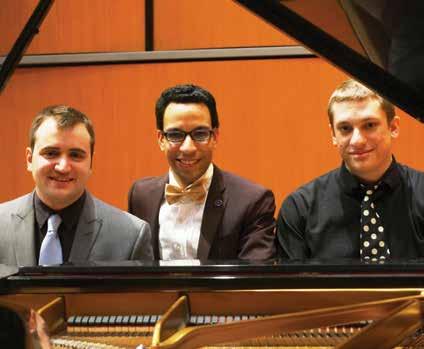
When seeking speakers for the 2015 Darwin Festival, the Salem State University biology department was thrilled to include a former student. Isaiah Gomez, who graduated with a bachelor’s degree in biology in 2013, presented “Cures in the Ocean: Marine Natural Products Drug Discovery” during the university’s week of Darwin-inspired lectures that were open to the public.

Gomez, who went on to earn master’s degrees in chemistry and biochemistry from the University of San Diego, explained how his recent medical research analyzes samples from plant organisms in the ocean.
He is working on a number of experiments and hopes to return to Salem State to present his future findings and describe how they are advancing cancer research.
Students at the presentation came away with confidence that they, too, could find success with their degrees. Professors in attendance left secure in the knowledge that their students are having an impact on the world. n

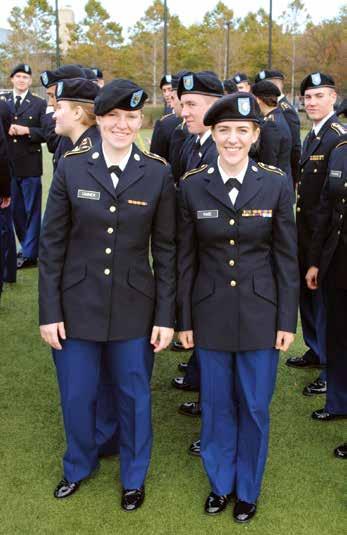 by KeLLY TANNeR ’17
by KeLLY TANNeR ’17
Since I was a little girl I have dreamed of joining the military. I was introduced to the idea by my oldest brother Greg, who explained the many ways I could serve this great nation. Achieving it became a strong desire, in part because it is a way for me to give back to the country that gave me a second chance at life.
I came to the United States as an adoptee from Chisinau, Moldova, in May 1997, becoming the youngest and only girl in a family of six children. Growing up with five older brothers, I’d be the least likely to join the military, you’d think. I was determined, however, to make it happen—and I have.
I joined ROTC, a rigorous program that begins with morning physical training sessions three days a week from 6 to 7 am, followed by college classes that begin at 8 am and conclude in the afternoon. On Wednesday evenings I participate in leadership laboratory, which exposes me and my fellow cadets to training exercises conducted in both the classroom and the field. All cadets are required to attend military science class once a week, which gives us formal classroom instruction on military topics.
On top of all this, I participate in varsity sports, work a part-time job and take part in extracurricular activities at Salem State. ROTC has helped me develop and understand how important time management is. Finding a balance between ROTC, school, sports, and work has made me realize that if you set your mind to it, you can achieve your goals regardless of how ambitious they may be. The journey through ROTC has been a rollercoaster ride, but a rewarding one for I earned a scholarship during the second semester of my freshman year.
Army ROTC has given me a wide range of both physical and mental experiences. I have been tested beyond my limits during physical training, running obstacle courses at Fort Devens and Camp Edwards. In classroom settings I have developed my leadership and communication skills. Among the most valuable things I have gained from ROTC are the relationships with my peers and cadre members. I have had the opportunity to create a close network and support system that I know will be with me long after I commission. The comradery and candor I have established with my fellow cadets has given me the confidence to take on any responsibility— and lead my peers in effective ways.
One of the most important things I have realized growing up is that there have always been people to help and support me. They have made things such as ROTC possible. I’d like to express my appreciation and gratitude to Lieutenant Colonel Peter Godfrin, Major Cara Salmon, Master Sergeant James Myers, and my brother Greg Tanner for being exceptional mentors. They will continue to be so as I pursue my commission as a future leader for the United States Army. n
Sheryl Sandberg, the chief operating officer of Facebook, wrote a book that advises women to “lean in.” But for a freshman—woman or man—it’s not that easy. At least not at first—and not for me. But I finally did, and this is how it happened.

Coming to Salem State University as a freshman, I never imagined that I would be able to make a difference in the world. My goal was small, or so it seemed. I wanted only to better the lives of the people around me. That, after all, is why I had gone into psychology. A few months later, I declared my second major, English with a creative writing concentration. My goals had grown, and they now included being a successful writer.
But as soon as I declared my second major, people started doubting me. They said I was crazy for double majoring and that there was no way I could graduate on time. Their negativity first overwhelmed me and then inspired me.
Over the next couple of years, I struggled to make a difference in my peers and myself and, during fall 2014, I tried two things. I joined the Residence Hall Association as vice
president of community council for the Bates Complex, and I began interning in the university’s marketing and communications office.

Those decisions opened the door. I was able to begin planning events for students, report on what was happening on campus and, in my opinion, improve my own life as well as the lives of others.
My excitement, however, was short-lived. A few months later I was thrown for a loop when my home situation was in turmoil. I tried to gather myself and get back to the progress I had been making.
Surprise! That moment happened. As an intern in the university’s marketing and communications office, I was asked to sit in on the editorial advisory board meeting of administrators, faculty and alums to figure out a direction for Salem Statement, the university magazine. What were we looking for in the upcoming edition? What theme did we want to have? I figured that I would just be an observer, sitting on the sidelines and taking notes like the good student I am. But that didn’t happen. I was asked my opinion of
the magazine and when I spoke the committee actually listened to me. They took my opinion into consideration and we began to have a discussion about some of the things I had pointed out. From there, the whole table came together and had an “a-ha!” moment. To me, it was a miracle.
To actually be heard and be seen as an equal instead of just a student was nothing short of amazing. It was wonderful sitting there and discussing topics I thought should be added to the magazine as well as simple suggestions such as where to place the magazine on campus or around the community.
I finally felt like I could make a contribution. That feeling has stuck with me ever since.
Everything I was hoping for came together at once. My opinions matter. My voice matters. I am more than just a student. I am a person who can make a difference. And I wouldn’t trade that for the world. n
 by sTePHeN YOUNG
by sTePHeN YOUNG

It is hard to believe that the world is warming, but it is. Scientists use the term climate change to describe the overall warming of the planet and the uneven changes (colder in places, stormier, changes in precipitation patterns) that the planet is experiencing.
of
6
While we were shivering, much of the Arctic region and many other parts of the world were unusually warm. In fact, the Iditarod (Alaska’s famous dog race) had to move more than 200 miles north to find enough snow while the Arctic Sea never froze to its normal extent. Ski resorts from California to Washington closed early because of a lack of snow, and San Francisco didn’t have a drop of rain in January, normally its rainiest month, for the first time on record. According to the National Oceanic and Atmospheric Administration (NOAA), this past winter (December 1, 2014 – February 28, 2015) was the warmest on record globally (back to 1880). It is also off to its warmest start (January and February) of any year on record.
If the world is warming, how did we end up with cold temperatures and lots of snow? There is strong evidence that the Arctic region is warming faster than other regions of the world and the jet stream’s typical patterns
are changing, as evidenced from the past two winters and everybody’s new favorite expression—“polar vortex.” With the loss of sea ice in the Arctic, the jet stream bulges, bringing warm air to Alaska and the Arctic while pushing cold air down to the central and eastern United States.
Meanwhile, as the globe has been heating up for the past few decades, most of the warmth has been stored in the oceans. Warm water releases more moisture to the atmosphere and, while New England was frigid, the waters off New England were abnormally warm. That warmer water fed moisture to the atmosphere and a low pressure cell drew that warm moist air ashore, where it rapidly cooled, causing snow—and more snow.
The NASA image of the earth’s temperature for February 2015 shows the east coast of the United


States in a bubble of cold air, with much of the world warmer than normal and abnormally warm water off New England’s coast.
The world is warming because of the excessive amount of carbon dioxide we are putting into the atmosphere from the burning of fossil fuels. Because our climate is complex, this warming will continue to change our environment in unusual ways. Salem State’s geography department is studying the earth from space, using satellites, and we are monitoring changes, such as sea-level rise along the North Shore, as well as analyzing ground-based weather data.
It’s not just faculty doing the research. Students are getting first-hand experience as well. Graduate students Paul Curtis and Hengzhi Hu published their research on satellite-based temperature change in northeastern North America in the journal Northeastern Geographer. Undergraduate student Lindsey Rogers has analyzed climate data from multiple stations across every state in New England between 1895 and 2012, finding that every New England state is warming, especially Massachusetts. Her research was published in the International Journal of Undergraduate Research
Salem State University is actively involved in climate change issues from the science of global warming to climate solutions. n




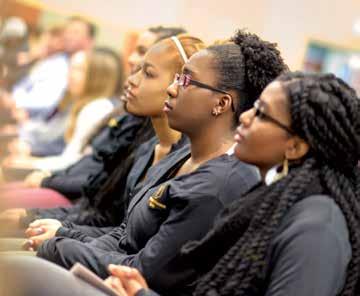


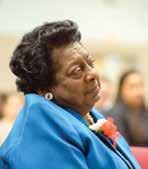


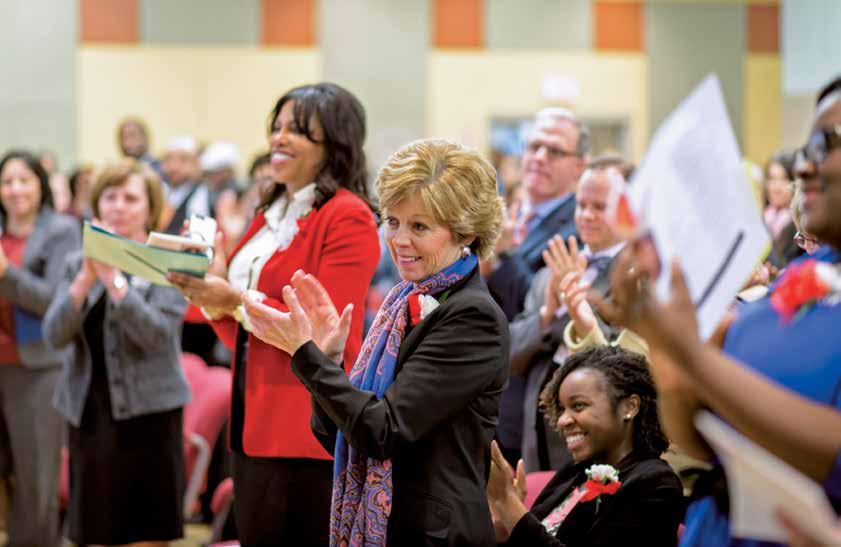
The charge from Ilyasah Shabazz, daughter of slain human rights activist Malcolm X, could not have been clearer at this year’s 25th Martin Luther King Jr. convocation. The keynote speaker—in a passionate address—exhorted students to “give back to society in some significant manner.” She encouraged members of the audience to “demonstrate to the world your greatness, sons and daughters of promise. Define a legacy of your own. Don’t simply memorize text to pass the test.”
The theme of this year’s milestone celebration was, “Our Journey Toward Justice.” A weeklong event in January began with a candlelight vigil and freedom march and ended with the annual MLK convocation. During the week, members of the campus community and the public participated in a wide range of workshops, panel discussions, school essay contests, and a day of service.
At a reception that concluded the event, essay contest winners from area public schools shared their thoughts on Rev. Dr. King’s legacy and the Martin Luther King Jr. Leadership Award was presented to student Gloriana Diaz, faculty member Tiffany Chenault and staff member Jay Carey for their work in reaffirming the legacy of Dr. King. n
Above, university chaplain l aura Biddle, foreground, and M l K convocation participants appreciate one of the student musical performances. On the opposite page, clockwise from top left, are student musicians Fedrice Isidore and Solome Nakimule, trustee chair Pamela C. Scott, assistant dean Shawn Newton, student members of the Bold, Educated, Empowered Sisters (BEES), and keynote speaker Ilyasah Shabazz.
sTUDeNTs eNCOURAGeD TO “GIVe BACK TO sOCIeTY IN sOMe sIGNIFICANT MANNeR”Photography by scott Booth
ULTIMATe FRIsBeeTM Te AM BRINGs ALUMNI, sTUDeNTs TOGeTHeR

 by BRION O’CONNOR
by BRION O’CONNOR
Photography by David sokol
IT IS ThE qUINTESSENTIAl SPRINGTIME COllEGE CAMPUS TEMPERATURES RISING, BIRDS ChIRPING, FlOWERS AND TREES
BUDDING, AND STUDENTS CASUAlly TOSSING A FRISBEETM ON CAMPUS. FOR MEMBERS OF ThE SAlEM STATE UNIvERSIT y UlTIMATE FRISBEETM TEAM, NICKNAMED ThE NORSE FORCE, ThE ARRIvAl OF SPRING MEANS ThEIR SEASON hAS KICKED INTO hIGh GEAR.
There is nothing casual about these games. Ultimate is a dynamic sport, say Norse Force members. Chrissy Amaral ’15, a sport and movement science major with a concentration in recreation management, was introduced to the sport by friends as a freshman. She quickly recognized the challenges, both mentally and physically.
“No one realizes how demanding the sport is,” said Amaral. “You need the cardio and agility of a soccer player and the jumping and pivoting skills of a basketball player.
“There are organized offensive and defensive strategies, and (the game) has its own unique field progression,” said T.J. Gansenberg ’11. “It’s played on a field with end zones, but the game is much more lateral than sports on similar fields.”
The Norse Force came together five years ago under SSU alumni
Gansenberg, Ben Naismith ’14, Andy Seidel ’12, Paul Couture ’12, and Matthew Royal ’12. As a universitysponsored club sport, it is run by the players and any current Salem State student can join. “The game is easy to learn but difficult to master, so it’s a good time for players of all levels,” said Royal.
“Our team is unique because we have a volunteer coach, but at the end of the day, we (the players) decide the team’s direction,” said Amaral. “We elect captains and an executive board, and each year is a new start.”
In spring the SSU Ultimate squad plays a full slate of collegiate-sanctioned tournaments. For these events, only current students are eligible, although alumni often pitch in to coach.
The group is far more inclusive when it comes to non-sanctioned events; here alumni can play alongside students in some situations. The typical Ultimate game features seven players per team, but there are many variations depending on field size. There are “open” games, “mixed” (or co-ed) games and even games where teams are randomly selected by pulling names out of a hat.
The more the merrier, they say. “The best thing about the sport is the people,” said Royal. “Players are driven, athletic, kind, open-minded, and overwhelmingly welcoming.”
That welcoming aspect is essential for Royal. He started playing Ultimate Frisbee TM roughly a decade ago, in high school. “At the time, I weighed about 350 pounds and was really, really


unhappy with my life,” he said. “Ultimate really helped me dig myself out of that hole and gave me some inspiration to better myself.”
The solidarity the game engenders is a constant. Talk to any Norse Force member, and you’ll get a version of the same response: Ultimate is all about the players. “The best part of being on a team is the camaraderie,” said Anthony Bevilacqua ’13. “Ultimate is a huge community, one that is accepting of players at any skill level. I’m good friends with beginners and others who play in the pro leagues.”
Part of that equation is the importance of working together.
“Ultimate teams are like families,” said Gansenberg. “You rely on your teammates to support you and bring you up when you’re getting frustrated, and you rely on them to be hard on you and whip you into shape when you’re not making the throws or catches you need you to make.”
Ultimately it’s about having fun, staying active and trying to win together, said Amaral, who added that the travel opportunities only add to the overall experience.
And—in those perfect moments— Ultimate helps players escape the outside world. “My favorite part of the game is the place I go when I’m playing,” said Gansenberg. “There are moments when you have no sense of time. A second or 10 seconds or three minutes can all feel the same. You aren’t concerned with what work needs doing when you get home or what bills you need to pay. You are ‘in the moment’ with 13 other people who know the exact same feeling.” n
In late February, President Meservey joined Montserrat College of Art (MCA) president Stephen Immerman in announcing that the two institutions had entered into formal discussions regarding the feasibility of the art college, based in Beverly, joining Salem State. The announcement was made at the conclusion of a four-month confidential due diligence process between the two.
“The potential of possibly joining these two institutions is exciting,” said Meservey, “and collaboration would expand access to a broader array of
artistic and student-centered facilities on both campuses. For students, this would be a unique academic program on the North Shore,” she explained.
Monserrat College of Art is a small, private residential college of visual arts and design that was founded in 1970. With an enrollment of 385 students, it offers a bachelor of fine arts degree, continuing education classes for teens and adults and four galleries exhibiting works by international, national and regional contemporary artists.
The boards of trustees on both campuses have agreed to move the


exploratory process forward by extending the due diligence work and delving more deeply into the many details such an effort entails. Faculty and staff from both campuses are currently evaluating both the potential benefits and the impact on students, faculty, staff, alumni, and supporters at each institution.
The goal is to have a final decision and—if that decision is to go forward —an agreement in place by July 2015. Full implementation would take effect during the 2017-2018 academic year. n
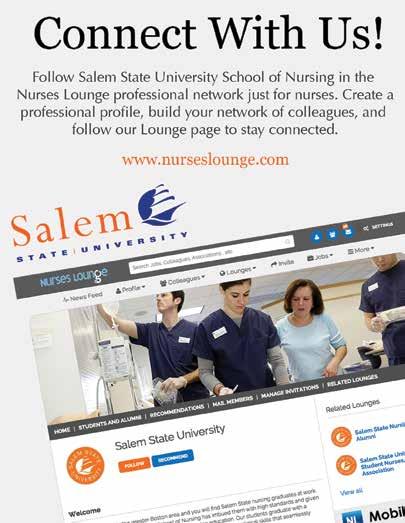
The second annual Careers in English panel, held in March, brought eight alumni English majors back to campus to speak to current students about their respective roads to employment. This year’s panel included Jessica Brown ’05, Amanda ThomsonTangalin ’11, Kayleigh Merritt ’08, Melissa Mui ’13, Carmen Barefield ’14, Chris Zybert ’11, Kat Casey ’13, and Kimberly Yennaco ’14. Nearly all advised students to connect with LinkedIn, be flexible, do research, network, intern as much as possible, join the online magazine Red Skies, analyze, be detail oriented, and put oneself out there.
Participants also told current students not to worry if they hate their first job, as “no first job is meant to last.” Thanks to the members of the alumni panel, the students in attendance will know what to expect when they graduate.
The career-focused event was organized by English professor Scott Nowka and the English Honor Society. n


On March 28, 2015, The Friends of the School of Social Work were proud to present their annual Alumni Social Worker of the Year award to Peter MacKinnon ’04G at the spring professional development workshop. Peter currently works as an adolescent unit supervisor in the Lowell area offices of the Massachusetts Department of Children and Families (DCF). For the past three years, he has also served as president of SEIU Local 509, the staff union for DCF social workers.

In nominating Peter for the honor, professor Mary Byrne described him as “an outstanding supervisor whose leadership fully embodies the mission and curriculum values of the School of Social Work.” Congratulations, Peter!
In November 2014, the Bertolon s chool of Business (B s B) Alumni Network unveiled the new business card wall located within the school. Hundreds of alumni have already submitted cards to be displayed, and you can too! If you’d like to serve as a resource for current students, please send in your card today. Cards can be mailed to the alumni affairs office, 352 Lafayette s treet, s alem, MA 01970, or scanned and emailed to alumni@salemstate.edu.



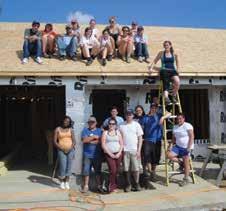


 by VICTOR DeRUBeIs
by VICTOR DeRUBeIs
Massachusetts public schools have been named the best in the nation by Education Week, the pre-eminent national publication covering education. But with a score of 86 out of 100, there’s plenty of room for improvement say professors and administrators at the Salem State University School of Education.
To ensure our public schools remain on top—and to secure that coveted ‘A’ in the future—Dr. Joseph Cambone, now entering his second year as dean of the School of Education, has outlined an ambitious agenda of program enhancements and community engagement designed to take teacher training to the next level. Current initiatives include:
• The cornerstone 4+1 master’s degree program, which puts future teachers in school classrooms beginning freshman year
• An after-school program that puts student teachers in paid positions at the schools in which they teach during the day, providing continuity for them and the children they serve

• A new student advising center to keep students on track to graduate and to follow up with new graduates

• An effort to build more relationships with school systems and to provide expanded opportunities for Salem State’s education students


A fourth grader named Jada is seated at a computer, oblivious to the sunshine. She’s transfixed by the story she’s writing about fantastical ponies and trying to follow the online suggestions of her after-school teacher, Salem State University senior Jillian Fitzgerald.
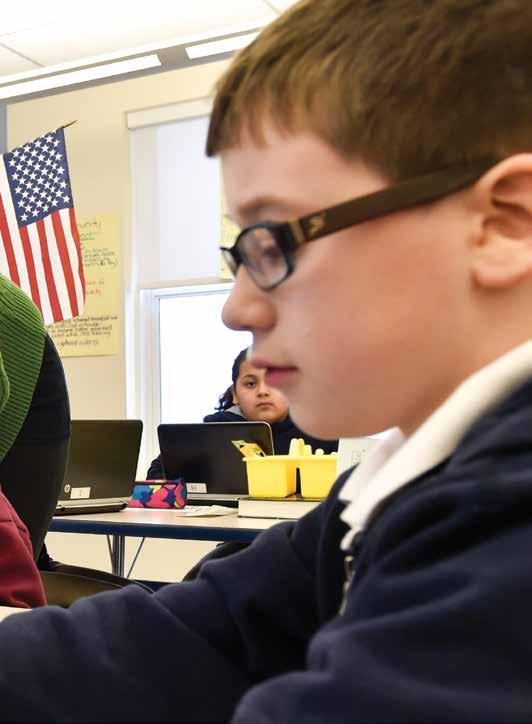
Tapping and deleting. Tapping and deleting. Finally Jada gets it the way she wants it. For now.
“I want to be an author when I grow up,” she says.
In a very substantial way, she already is, and Fitzgerald has been helping students like Jada get there. The teacher adds the human touch of encouraging notes to a software program being tested to help older kids improve their writing. Using computers to help kids learn is nothing new, but having highly qualified, paid teachers-in-training help them out? That’s something novel.
practica at the end of the school day and head to their paying jobs at pharmacies, restaurants or supermarkets to help pay the bills. Now, thanks to a pilot program in which Salem State has partnered with the Revere public schools, Fitzgerald and fellow senior Gabrielle Mari of Beverly are being paid to stay after the regular school day and provide academic enrichment—or sometimes just a listening ear—to students in the K-5 elementary school.
It’s proving to be enriching beyond expectations, according to Fitzgerald, one of six student teachers from Salem State at the Revere school during spring semester. And it sure is for Lilly Guido, the after-school program coordinator for Revere, a so-called “gateway” city with a highly diverse immigrant and nonEnglish-speaking population. “These are part-time employees of the schools— college students in the education field who want to pursue education as a career,” says Guido, who’s particularly pleased with the continuity that student teachers like Fitzgerald and Mari provide. “We’re hoping we can put this through for all the elementary schools,” Guido adds.
It used to be that most student teachers would leave their unpaid continued on page 20

The after-school program is just one of the initiatives Salem State University is undertaking as it continues to overhaul the way teachers are trained. The university’s School of Education is at the forefront of innovative programs that played a role in recent good news. Education Week, the national weekly that covers education, named Massachusetts public schools the best in the nation in a recent assessment that looked at a number
of criteria, including funding and performance on standardized testing, to determine rankings.
But while Massachusetts was rated first, it still scored only 86 out of 100 percent. A solid B by any measure, but to those who train teachers at Salem State, that’s not good enough, even though the nation as a whole earned a C.
When it comes to early childhood education, the picture gets less rosy, with Massachusetts earning a C and the rest of the nation receiving a D+.
Long before Education Week said Massachusetts was a B student, however, professors and administrators at Salem State knew that while the state’s public schools may be the best in the nation, the commonwealth still could do a better job of training teachers.
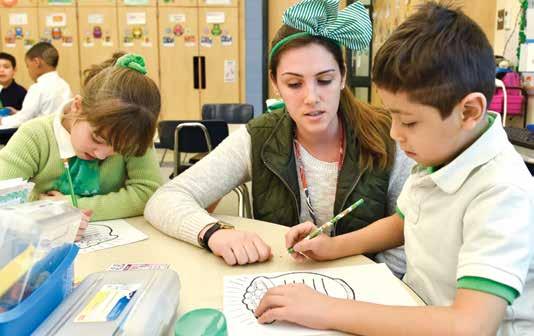
In January 2013, the university formed the Education Working Group of the School of Education after an independent external review noted that, while Salem State had a proud history of innovation dating back to the 19th century and the old Salem Normal School, it needed to establish a new direction in order to become a regional and national leader in teacher training.
Convened in September 2013, it came up with a number of program changes and a mission statement that
reads in part: “students, faculty and partnering institutions work together to advocate for positive change, (and) translate theory and research into practice.”
Revere’s pilot program is one of the locations where the university is putting theory into practice. Francesca Pomerantz, a professor in the School of Education and the lead faculty member for school and community partnerships, first approached Revere about the afterschool program as a way to augment the student teaching experience.
“It’s my job to identify schools where things are working and match students to them,” says Pomerantz, who interviewed Paul Revere principal Barbara Kelly ’79, ’94G and assistant principal Bianca Quirk ’02 before visiting the school with assistant professor Anneliese Worster and others to see for herself what was going on in classrooms.
Among the questions they asked themselves: Was the climate in the classroom one of mutual respect and support? Did the teacher create opportunities for collaborative and cooperative learning experiences? Was the content relevant to a diverse population of learners?
It’s a series of questions they plan to ask at other schools as Salem State ramps up its 4+1 teacher training program, which lets students begin classroom teaching in their freshman year. They complete their fifth year with a master’s degree, full state licensure and 22 weeks of student teaching instead of the usual 15. It’s a break from the traditional system where teachers complete four years of college, take their licensure exams and then take several years to complete the master’s degrees they need to retain their professional licenses.

Raise the topic of report cards, and childhood memories come to the fore. Receiving regular reviews of my academic performance was always a memorable experience. My teachers in the Melrose public schools would inscribe each grade in bright blue ink, and I would take the card home to my parents for their signature.
It would never have occurred to me that my school—and all of the nation’s public schools—are also graded now. Education Week Research Center regularly reviews America’s schools and scores each state on its performance. In 2015, Massachusetts tops all 50 states with a grade of B (86 out of a possible 100) and is cited as, “a perennial high performer that has consistently finished among the nation’s top five.”

Cleti Cervoni, associate dean of salem s tate’s school of education, is delighted but not surprised. “There are many components that lead to school excellence,” she explains. “Among them are experienced and well-trained teachers and principals and community engagement programs. salem s tate has been at the forefront of educating teachers for success in the classroom since its founding over a century and a half ago—and we’re in it for the duration.”
It is hardly a reach to postulate that salem s tate University is a big reason Massachusetts scored the nation’s highest grade. Its graduate school, in particular, provides the advanced training that continues to propel teachers and school administrators into top positions within the commonwealth’s schools. As it works to increase its 2015 ranking from good to great, the state’s Department of Higher education will continue to look to the university’s graduate school for the credentialing, advanced licensure and re-accreditation resources that make for outstanding teachers and school administrators. Likewise, schools from Boston to w illiamstown will seek out educators trained and certified at salem s tate. It takes more than well-educated teachers and administrators, however, to achieve and maintain excellence within the state’s school systems. Mutually beneficial alliances between the university’s graduate school of education and surrounding school districts often pay big dividends for both as well.
“The purpose of the graduate programs within the school of education,” says Cervoni, “is twofold. e xperienced educators and those already in the field come to salem s tate to improve their skills; meet, learn from and collaborate with peer colleagues; earn the credentials and certifications necessary for advancement in their professions; and learn new ways to provide educational enrichment for their students. Prospective educators—those who wish to either complete the requirements they began for teacher licensure as undergraduates or who have decided to make a major career change and enter the teaching field—” she notes, “also find the support and resources they need on salem s tate’s campus.”
One thing is perfectly clear: As Massachusetts teachers and school administrators continue the good work that has placed the commonwealth at the pinnacle of educational success across the nation, salem s tate’s graduate school of education will be increasingly called upon to help them—and the state’s schools—not only maintain current performance but surpass it in the future.
 —Ann Carlson
—Ann Carlson
(
If you visited Allegra Marrone’s third-grade class at the Paul Revere school on a recent Tuesday morning, you’d certainly come away with the impression that the room fosters support and collaboration. Olivia Shluger is part of a team that’s helping a group of students teach themselves about the abstract nature of parallel and intersecting lines and line segments. She introduces the concrete application of those concepts via a map of the school neighborhood, asking students to identify the parallel and intersecting streets.
The kids are on their best behavior, of course, because of the visitors in the room, but other classrooms at Paul Revere give the sense that this is the norm and not the exception.

Jillian Fitzgerald ’15, the student teacher in Terry Incerto’s first-grade class during the regular school day and an after-school program worker, says she almost can’t believe in her good fortune at finding a school with the atmosphere of collaboration, support and teamwork she has found here.
Her colleague, Gabrielle Mari ’15, who student teaches during the regular school day in Alison Buonome’s first-grade class, agrees. Mari transferred from another institution after deciding that maybe she didn’t want to be a doctor after all.

“I always loved working with kids,” says Mari, who coaches lacrosse and describes herself as the ‘neighborhood teacher.’ Once I got in a classroom I knew this was where I wanted to be.”
Pomerantz
is helping establish a second pilot program in Danvers. Although a more suburban district, the town has a lot of the same challenges as Revere. Additionally, it has a high population of homeless families living in the town’s many motels.

Salem State is making a conscious effort to target areas in which Massachusetts is considered weakest, but its philosophy is that students in a community such as Revere, which may be perceived as chronically underachieving because its socioeconomic demographic differs substantially from its wealthier suburban neighbors, can succeed. That will only happen if high standards of achievement are set for all.
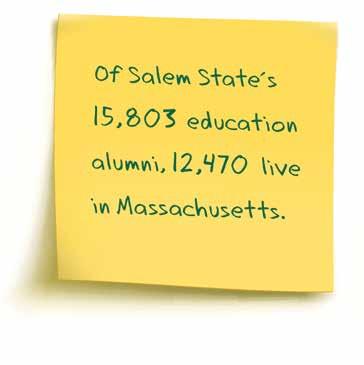
According to Professor Mary-Lou Breitborde, “The ethnic, racial and linguistic diversity of our ‘gateway’ enriches the cultural and educational experience for the children in our schools and for all of us lucky enough to live here. Given Massachusetts’ immigration rates and diversity, our standards and the progress our students make in reaching them are remarkable.”
Breitborde notes that the university’s new programs engage School of Education students in early and intensive field experiences in classrooms, schools and communities. These are supported by formal partnerships with schools, districts and organizations. The licensure programs, for instance, balance urban with suburban field experiences and require course work and competency in teaching English learners. They also require the ability to work well with families from a variety of backgrounds.

“Our licensure programs require five years and a master’s degree, reflecting the greater expectations for teacher knowledge and skills,” she says. continued on page 25
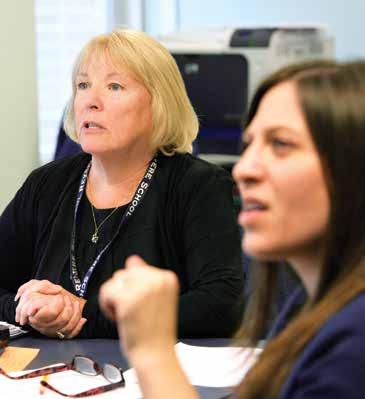
A new incubator for community education initiatives is planning a fall 2015 rollout of initial offerings. Under the auspices of the Salem State University School of Education, the Center for Community Schools will work to promote education as a community-wide endeavor, linking university faculty and students from mulitple departments with professionals in pre-kindergarten through adult education. Together they’ll work to implement demonstration projects, conduct policy research, share resources, and unite schools, after-school programs, cultural institutions, and other community-based organizations in shared advocacy. The overarching goal of the center is to promote and utilize schools as service hubs for all members of the community.

Funded largely by grants and private donations—the largest being an estate gift from Claire Crane ’60, ’09 h, former principal at the Robert l . Ford School in lynn—the center is now vetting its first partner institutions and planning conferences for the upcoming academic year. Among its earliest priorities will be professional development offerings to community-based staff focusing on college and career readiness strategies and college access for underrepresented groups.
Enlisting Salem State alumni in the communities where they work will be essential to the long-term success of the center. Those wishing to get involved are encouraged to contact Dean Cambone in the School of Education at 978.542.6266 or jcambone@salemstate.edu.

Negotiating the thicket of available courses requires advice from those with an expertise on the proper career path, be it early childhood, elementary, secondary, or the rapidly evolving fields of community and environmental education.



That’s where Johanna Morgen and team step in to help. Morgen is the director of student services in the School of Education, a newly created office housed in a former computer lab on the third floor of the Sullivan Building.
On a recent Friday afternoon, Morgen is advising a freshman on the courses she should take in the fall, the first semester of her sophomore year. “American Lit 1 or 2? World history, world culture and then you’re all through your ‘gen eds.’ That’s awesome,” she tells the student, one of many who need assurance that they’re taking the right courses at the right time to coordinate with their classroom experiences and their college and career goals.
“We go to the students. We don’t leave it to the students to come to us,” says Morgen, who also works to build relationships with student advisers for their minors, be they in the sciences or the humanities. “Rachel (Della Croce) and I are advising all of the freshmen, and we want it to be a focused and organized experience,” she says.
That means a color-coded system for flagging students in need of extra help: green for the student ready to take the next Massachusetts Test for Educational Licensure (MTEL), required for certification; yellow for the student with an incomplete in a core course and in need of suggestions for improvement; red for the student whose grade-point average has fallen below 2.0 or may be failing a course. In the latter case, the student receives an email or text that says, “I need to see you this week.”
continued on page 26
While the advising process may seem like hovering to some, Salem State is trying to address part of a national problem: the need for improvement in classroom preparation so teachers don’t end up leaving the field after just a few years on the job. Roughly half a million U.S. teachers leave the profession each year—attrition that costs the United States up to $2.2 billion annually, according to a 2014 report from the Alliance for Excellent Education. The nonprofit tracks education trends, especially those in poorer communities.
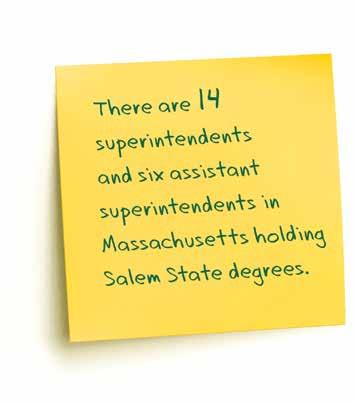
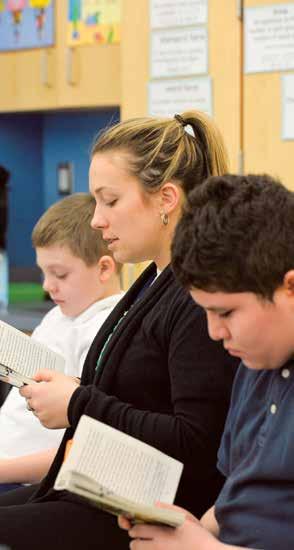
To ensure that doesn’t happen, those intending to teach need to start the MTEL process in the freshman year. The philosophy is that students fresh out of high school are more used to the rigors of standardized testing and are more likely to do well on the exam. Beginning the test process earlier also preempts a common complaint among teacher candidates: that waiting until the senior year to take the MTELs is overwhelming.
Putting education students in the classroom early also gives them a way to find out if they’re pursuing the right career. They may have loved their secondgrade teacher, but that doesn’t mean they’re going to like being a teacher. There are alternative pathways in place for students who seek a career in education but do not necessarily feel comfortable as a classroom teacher.
The student advising center’s work continues through the master’s degree year of the 4+1 program and beyond. Morgen’s office contacts alumni throughout their careers—beginning one to two years after graduation—to make sure their experiences are meeting their expectations.
“An age-old argument over the ‘best practice’ for all students has been replaced by efforts to prepare educators with many tools and approaches— approaches that are responsive to diverse populations and learning styles,” says Breitborde. Her study of the theoretical has been put into practice for many years by Salem State alumna and Revere High School teacher Nancy Barile ’03, a national board-certified teacher who won the Kennedy Center/Stephen Sondheim Inspirational Teacher Award in 2013 and was one of the top 50 finalists for the Varkey Global Teacher Prize.
“I love mentoring teachers,” says Barile, who has conducted numerous workshops and given many speeches about what works for her and how teachers can adapt innovative methods to their personalities. She especially loves the challenge of “reluctant learners” because she was one herself.
She cited the example of a student from Cambodia who grew up amid a swirl of gang activity in her neighborhood. “I kept in touch with her, and she went on to get a degree. She then decided she wanted to be a teacher, came back to the Revere public schools and then earned a master’s degree at Salem State.” The student, Ledra Sun ’13, last year received an award given to young teachers who are making a difference in the world.
Barile, in acknowledging Breitborde’s work, says teachers still need to be able to connect with students. “Teachers must have great content knowledge,” she says, “but if you aren’t able to make the learning relevant to the students, nothing’s going to work.” n
People don’t go into education to get rich. According to Joseph Cambone, dean of salem s tate’s school of education, they needn’t take a vow of permanent poverty either.
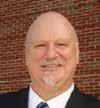
“we want our candidates to be less distracted by making ends meet and completely focused on the final intensive year of their clinical training,” Cambone says. “we want these highly qualified and highachieving candidates to incur no additional debt to earn their master’s degrees.”
Here, the 4+1 program is a big help. Master’s candidates take 21 credits of their graduate courses as part of their bachelor’s degree program, meaning senior-year courses that count toward the master’s degree are paid for at the undergraduate tuition and fee rate. Only the remaining 18 graduate credits, completed during the fifth year, are charged at the higher graduate rate. That means a 4+1 candidate can earn a 39-credit master’s degree for about $8,000 less than if they were to complete all 39 credits post baccalaureate (at today’s tuition and fee rates).
The university’s goal is to raise enough money in philanthropic gifts to help cover the other 18 credits, or $6,600, which is part of the reason why financial assistance is a top-level fundraising priority of the ongoing 10,000 Reasons campaign. The campaign to date has raised more than $19 million of its $25 million goal with nearly one-quarter of the cash in hand earmarked for financial assistance so far.


Your gift to the 10,000 Reasons campaign can support students in the school of education, or any other priority of your choosing.
salemstate.edu/reasons
V isit salemstate.edu/travel.php to see the full itinerary for these fabulous vacation destinations!
Have you always wanted to explore beautiful and historically rich Prague, Czech Republic? Get your tickets now for this fabulous trip!

PRAGUe CITY sTAY
OCTOBeR 9-16, 2015
$1,699 with cash or check $1,729 with credit card
Richard ’58 and Mary Jane Anderson
(pictured with henry Dembowski ’60, ’62G)
Andrew Christensen ’03
Mary Commager ’69
Michael Gilligan ’70
Claire Keyes
Dorothy and the late Kenneth ’90H McIlraith
Paul Petrowski ’66
Philip and Joanne ’68 Ricciardiello
(pictured above right with President Meservey)
Crosby society membership is extended to generous benefactors who have included salem state in their will or living trust, named salem state a beneficiary of their retirement plan or of an insurance policy or formalized arrangements to provide a future gift to the university.
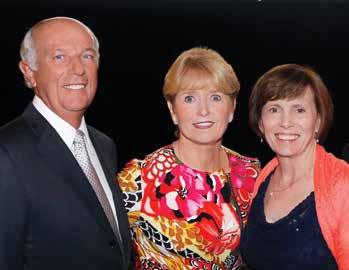

For more information about your philanthropic legacy at salem state University, contact:
Michael Randall Director of Major and Planned Giving 978.542.2345 // mrandall@salemstate.edu
by ALLAN sHweDeL

For all three I think of two university students studying to become teachers of English. Yana Z. and Yana S. are among a number of faculty and students with whom I have been working at Petro Mohyla Black Sea State University (PMBSSU) in Mykolaiv, Ukraine, under a Fulbright Specialist grant.

A recent variant of the better known Fulbright Scholar program that provides opportunities for American academics to conduct research abroad for periods ranging from one semester to a full year, the Fulbright Specialist program pairs Americans with specific areas of expertise with institutions in other countries to work on shortterm projects for a maximum of six weeks. Paired with the Institute of Philology at PMBSSU, I was to enhance teaching and learning through the use of rubrics and collaborative assessment over the course of three two-week visits.
Although many are already familiar with rubrics, they are not being used to maximum effect—notably as a tool for students to reflect on the quality of their work.
As in the States, teachers are trying to balance external mandates with their own instructional objectives in developing formularies. During my final visit in May, I will train faculty and students to use video annotation tools for collaborative assessment, and the university will convene a mini-symposium to share faculty and student experiences with rubrics and plan their next steps.
My work as a Fulbright specialist has also spawned connections between our two universities. Salem State President Meservey has already invited PMBSSU’s chancellor, the dean of the Institute of Philology and a representative of Ukraine’s Ministry of Education and Science to visit Salem State with the intent of signing a memorandum of understanding between the two universities. Opportunities for faculty exchanges are also beginning to emerge.
On reflection, I believe I have learned as much as I have taught through this experience, especially about myself as an American. In one class I observed, students were learning about courts and the legal system while staging a mock trial. The defendant was found not guilty by the judge. ‘Why?’ I asked the defendant, hadn’t he asked for a jury trial? There are no jury trials in Ukraine, I learned.
Someone mentioned that an American relative had been called to jury duty but didn’t want to serve, and a discussion about jury trials ensued. Most said they would not want to serve. I told them about the two jury trials I had been on and, while I was talking, I began to realize how very important to have taken part in the system is to my sense of being an American.
Serving as a Fulbright specialist has been an amazing opportunity, and it offers many different initiatives. I would encourage all readers of Salem Statement to consider exploring the various opportunities working with Fulbright provides. n
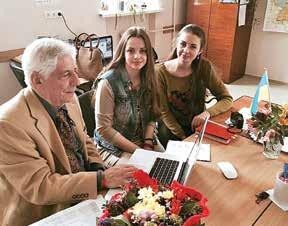

What’s
reaSOn 3 5 2 1
Jasiel
“I’m here at Salem State to work for a prosperous future and the opportunity to leave my mark on the world.”
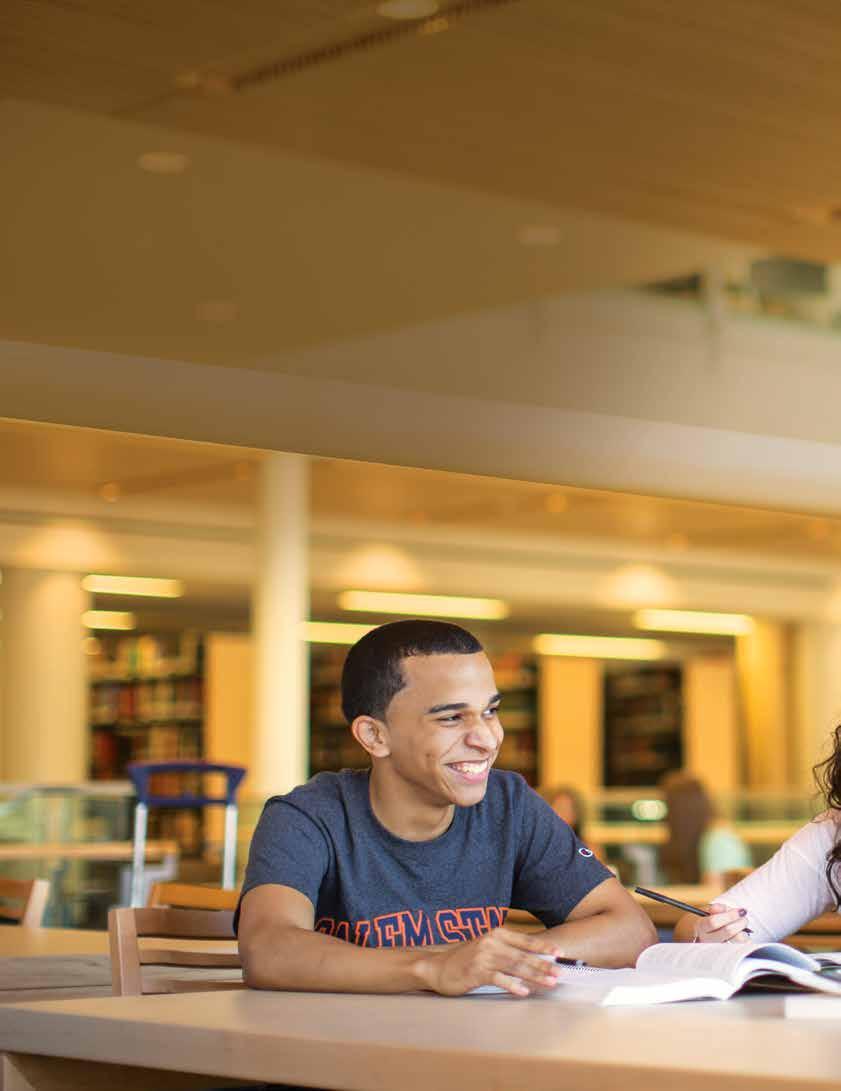
reaSOn 8 6 6 4
Colleen Wholley ’17 communications (PR)

“The faculty and staff here are so down-to-earth. They’re one big reason why I’m excited to follow in my sister’s footsteps as a Salem State graduate.”
reaSOn 9 0 9
“I’m a people person, and my favorite thing about being part of this community is how different we all are. Salem State has impacted my life in ways I never would have imagined.”

A sizeable campaign gift by Denise B. and Michael W. Gilligan ’70 made possible the early spring dedication of a Gassett Center office to former coach, athletic director and professor Bill Gillis ’66G. The March 27 ceremony brought together many of Salem State’s greatest names in men’s hockey from over the years, including Gilligan, who holds the distinction of being the university’s first hockey player to earn All-American status. Later, as Salem State head coach from 1975 to 1981, Mike led the men’s hockey team to 128 wins and just 48 losses, the second-highest winning percentage in Division II ECAC history.
The Gilligans’ gift recognizes a friend and mentor. After earning his master’s degree in education from Salem State in 1966, Bill Gillis stayed on to coach baseball, track-and-field and cross country. He then held the reins as men’s athletic director from 1975 to 1980, leading Salem State to victory in the Massachusetts Collegiate Athletic Conference’s highly coveted Howard C. Smith Cup no less than four times. Gillis retired in 1998 after more than three decades of service.
Marsh Hall 210 will now and forever wear the Petrowski name in recognition of a more than $400,000 commitment to the university by Paul Petrowski ’66. The lifetime Lynn resident had been toying with the idea of creating a scholarship at Salem State for several years, but had been unsure of just where to begin. It was the 10,000 Reasons campaign that cemented his resolve.
“All of us have an opportunity, if we’re fortunate enough to be successful, to give something back and do some good for somebody else,” he said. “It’s the chance to give other people the same prospects that we’ve enjoyed.” Once finalized, Petrowski’s scholarship fund will benefit students entering Salem State from Lynn Classical High School, with additional consideration given to those who are the first in their families to attend college, just as he was.
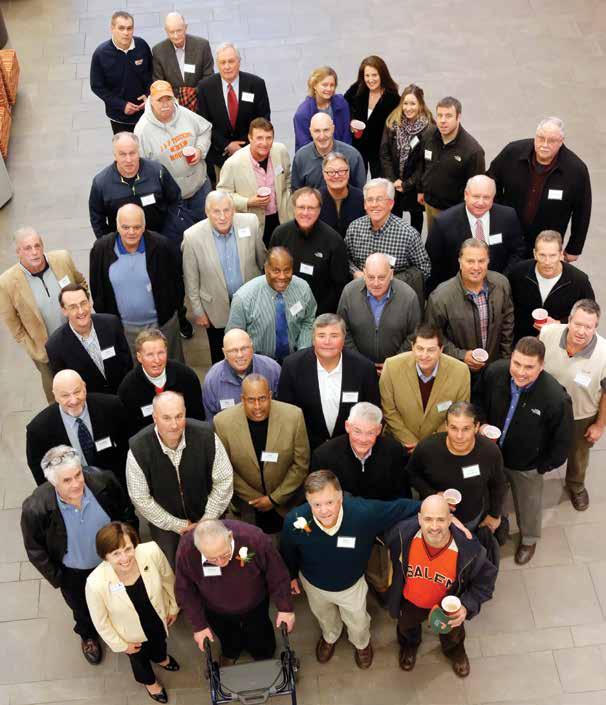



In January the Council for Advancement and Support of Education recognized university benefactors Bernard ’85H and Sophia Gordon with its Distinguished Friend of Education Award. Given annually, the award honors individuals whose volunteer service has helped to advance learning at an educational institution. In this case, the Gordons’ service spans several decades and many schools, from Tufts, MIT and Northeastern to UCSD and the Citadel. Lahey Health, the Museum of Science and Massachusetts General Hospital, too, have benefitted from the Gordons’ philanthropy—as have countless other smaller civic organizations.
Here in Salem, it’s the couple’s $3 million campaign commitment that is largely making possible the renovation of the Mainstage Theatre into the state-of-the-art Sophia Gordon Center for Creative and Performing Arts, which is scheduled to open its doors next year. But Salem State Foundation Executive Director Cynthia McGurren is quick to recognize that the Gordons’ impact on this university extends far beyond one facility. “They strengthen the communities that strengthen our entire region,” she said in nominating the Gordons for the award. “The context in which we all operate is richer because of their longstanding work and philanthropy, and that richness is a profound advantage to all of us in higher education.”
The 10,000 Reasons campaign’s second annual volunteer summit, hosted by its alumni and parents subcommittee on February 27, welcomed family representatives from the Pete Frates #3 Fund to the Harrington Building for a rousing keynote address. Beverly natives Andrew and John Frates (pictured here with President Meservey) are the brother and father of Pete Frates, the former Boston College baseball star whose three-year standoff with ALS captivated global media last summer at the height of the Ice Bucket Challenge. The Frates family helped to popularize the challenge, which originally began in Florida, as a way to raise awareness of, and research funding for, Pete’s disease. By the end of the summer, the challenge had funneled more than $100 million to the national ALS Association—a forty-fold increase in monies raised during the same stretch of 2013. Learn more or make your own gift at petefrates.com.



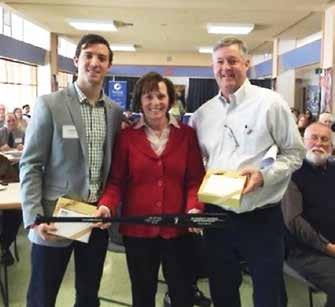

N ORMAN De LAN e Y of Corpus Christi, TX, has published his most recent book, The Maltby Brothers’ Civil War, to excellent reviews. One of Delaney’s many publications throughout the years, it tells the story of three brothers during the Civil War— two Confederates and one a celebrated Union general. In January, Delaney spoke eloquently about the Maltby brothers on C-SPAN2’s BookTV. His article, “Victory Has Perched on Our Banners,” was also included in the June 2014 issue of Naval History Magazine (A previous issue of Salem Statement incorrectly listed Delaney as Class of 1951.)

J AM es D I L I s IO ’s most recent book, Maryland Geography, was published by the Johns Hopkins University Press in October 2014. DiLisio has been a faculty member in the geography and environmental planning department of Towson University since 1975.
sU s AN H ARTM e R e ’72G recently returned from a humanitarian trip to El Salvador, where she and her team refurbished the interior of an abandoned school. Susan has been to Bolivia, India, Guatemala, Nicaragua, Costa Rica, and Brazil, each time with a different project. “I always get more than I give,” she said when asked about her exploits.
Middlesex Community College president CAROLe A. COweN ’69G, ’08H received the Massachusetts State Merit Award at the New England Board of Higher Education’s excellence awards ceremony. At the same ceremony, JAMes T. BReTT ’11H received the Governor Walter P. Peterson Award for Leadership.
Pe T e R L A C HAP e LL e is currently working on the restoration of the Washington Arch, a tribute to President George Washington erected on Salem Common in celebration of the 1976 U.S. Bicentennial. LaChapelle retired as chief of visitor services at Salem Maritime and Saugus Ironworks National Historic sites. He was also the president of Pioneer Village Salem from 1989 to 1993. ’77
Ge RALDIN e F. L UK e has been named dean of business and hospitality at Pennsylvania College of Technology. Luke had served as interim dean since July. Previously, she was a professor of business administration/management and marketing, receiving in 2013 the Veronica M. Muzic Master Teacher Award, the highest level of recognition for a college faculty member.
P ATRICIA ( wALL ) M C C AUL e Y is the director of the Clinical Resource and Simulation Center at Regis College in Weston. She received her MSN from Framingham State University and is currently a doctoral candidate at Regis. She is a certified healthcare simulation educator, a visiting scholar at Curry College and has presented at both national and international nursing conferences. Her work on an end-of-life simulation for undergraduate nursing students was published in the Journal of
The Salem State University Alumni Association invites you to celebrate your lifelong connection to Salem State by purchasing a personalized, engraved brick for Alumni Plaza, located in front of the Ellison Campus Center.
Add your name to the beautiful plaza, and leave a personal remembrance of your experience at the university. you may also choose to purchase a brick in honor of, or in memory of, a special Salem State graduate.
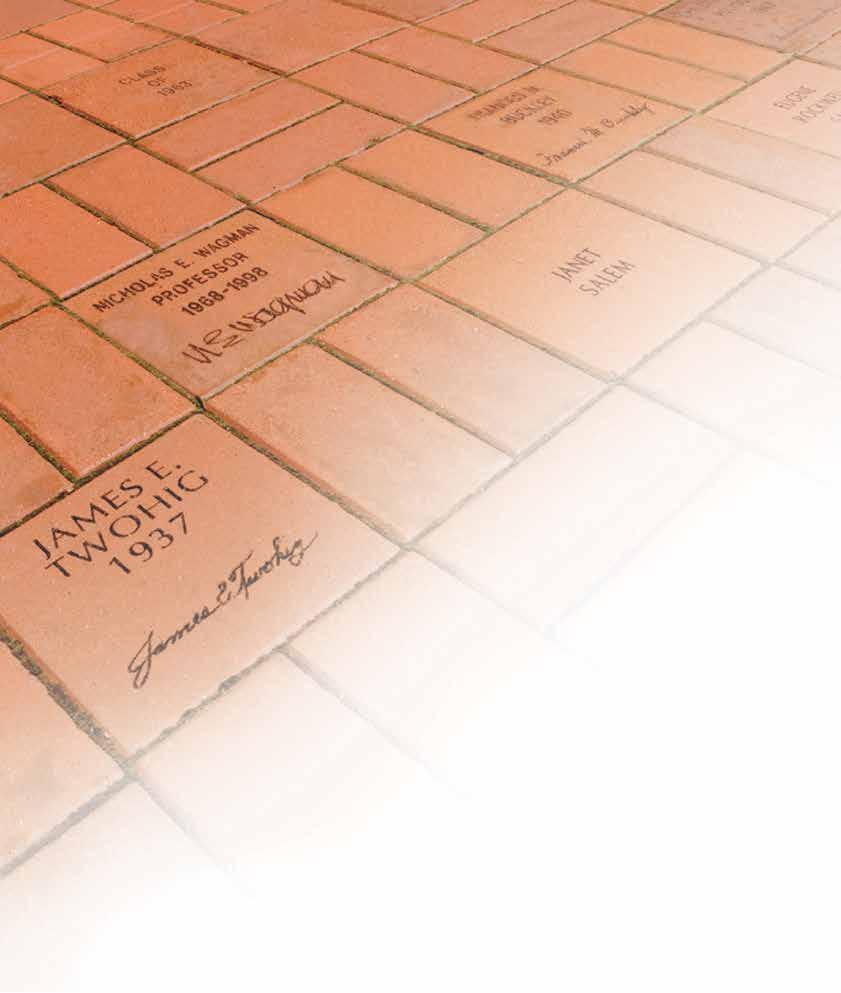
This project establishes a lasting tribute to alumni, parents and friends, and is a tradition for others to follow. Through the generosity of our alumni and friends, this program continues to increase the endowment of one of the university’s largest scholarship funds and has been providing our students with scholarship support since 1997.
Please print your first name, last name and year of graduation (if appropriate) in the spaces provided. If your engraving information exceeds 15 characters per line, or if you have a special request, please call the alumni office at 978.542.7530. Join us today and send your brick order to: Alumni Affairs, Salem State University, 352 l afayette Street, Salem, MA 01970.
4"x 8" Brick Inscription $100 (tax deductible)
One name per brick only. Fifteen characters per line and year of graduation.
8”x 8” Brick Inscription $500 (tax deductible)
One name per brick only. Fifteen characters per line and year of graduation.
Name ____________________________________________________________________
Address ___________________________________________________________________
Phone: (h) _____________________ (W) _____________________________________
*Note: The alumni association reserves the right to reject any request deemed inappropriate.
First Name
Number of bricks ordered at $100 each. Total Enclosed $ ___________
Number of bricks ordered at $500 each. Total Enclosed $ ___________
Payment method: Check payable to SSU Foundation/Alumni Plaza visa __ MC __ AMEX __ Act. #
Signature ________________________________________ Exp. Date: __ __ /__ __
’81
J OHN G. C RA w FORD , president and CEO of Ground Round Independent Owners Cooperative (IOC), was elected by the board of directors of the National Restaurant Association to serve as chairman until January 2016. The chairmanship is a volunteer position held by a member of the association’s board of directors who exemplifies exceptional leadership in the restaurant industry.
M ARY e . (B ARTON )
B UTL e R is the first woman to be appointed chief of police in Salem. Mary began her career with the Salem Police Department as a patrol officer in 1987. She graduated from Salem State in 1981 with a bachelor’s degree in social work and returned to earn a bachelor’s degree in criminal justice in 1996. She has been married for 28 years to Brian Butler, a patrol officer with the department since 1993, and is the proud mother of three great children.

’82
M ICH e LL e (C AR e) sPADAFORA has co-founded the Amesbury Children’s Theatre (ACT) in Amesbury. Michelle is a social work graduate who serves as a care manager for the Caregiver Homes AFC program. As artistic director of ACT, she is combining her love of theater with her social work skills to empower youth of all ages while teaching them confidence, self-esteem and the joys of live performance.
’86
Ke VIN w ee K s has been appointed president of the Association of Independent Consumer Credit Counseling Agencies (AICCCA). Weeks is a founding member of the Student Loan Alliance and served previously as a past vice president and trustee on the AICCCA board of directors.
’89
G UY C LINCH launched Guy Clinch Consulting LLC in 2014. Guy uses his wealth of communications industry experience to help companies grow revenues through innovative solutions to tough business problems. He has held positions at Avaya, Lucent Technologies and AT&T and contributes regularly on numerous industry panels and committees. He is a life member of the National Association of State Technology Directors and past chair of its Corporate Affiliate Council. Clinch also produces the widely subscribed podcast series, “Conversations between Peers in the Communications Industry,” on No Jitter.
’90
In January
C AR e Y F LYNN was named the new director of community relations for the All American Assisted Living community in Raynham. Prior to this, she was a sales representative at Coldwell Banker Residential Brokerage for 16 years.
T HOMA s F. F R e NCH recently joined AES Corporation as chief financial officer. He is chair of the Bertolon School of Business Advisory Council, has coached several Peabody youth sport programs for 14 years and has also been active with other organizations, including Peabody Western Little League and the North Shore Chamber of Commerce.
’92
M ARY A NN G RA ss IA , a first grade teacher at Witchcraft Elementary School in Salem for 22 years, received the Massachusetts State Universities Alumni Recognition Award and was honored at a November ceremony at the Massachusetts State House.
K IMB e RLY sHULMAN of Norton has joined United Way of Greater Attleboro/ Taunton, Inc. as its new director of finance. Kimberly most recently worked for BBA Remanufacturing and the Boch Ice Center.


Le AH A. M IL es ’ play Entangled , opened at the Davenport Theatre on West 45th Street in New York City in March!
Ke VIN M C G OFF was hired as a senior loan officer in the mortgage lending division at Jeanne D’Arc Credit Union. He has 25 years of mortgage lending experience and holds a bachelor’s degree in media communications.
Sponsoring an event with the Salem State University Foundation and Alumni Association is the perfect opportunity for your company to make an impression on one of the largest greater Boston alumni and friend networks—more than 70,000 strong. We offer several special events for networking and to advertise your products and services to a Salem State community of alumni, faculty, staff, donors, and friends.
Event sponsorship packages for 2015 range from $500 to $25,000. We can also customize a package at any level to include multiple events of your choosing. Contact Taylor Dunn at 978.542.7560 or tdunn@salemstate.edu for more information.
FRIeNDs OF THe sCHOOL OF sOCIAL wORK

sPRING wORKsHOP

sATURDAY, MARCH 28, 2015

ALUMNI weeKeND GLOBAL DAYs OF seRVICe
Thursday, May 28– sunday, May 31
$25 CASH BACK ON YOUR FIRST PURCHASE & 1.25% REWARDS REDEEMABLE FOR CASH BACK, TRAVEL & MORE!
A belated happy birthday from all of us to Martha Pistenma ’30, ’58, ’61G, who turned 105 years young this past November! The “Triple Viking” and retired first grade teacher is believed to be Salem State University’s oldest living alumna. President Meservey was sure to honor that achievement with a special visit to the birthday girl’s home on Cape Ann, where she joined Nancy Porter ’62 and Anne Cuff ’71 to swap stories and good wishes.
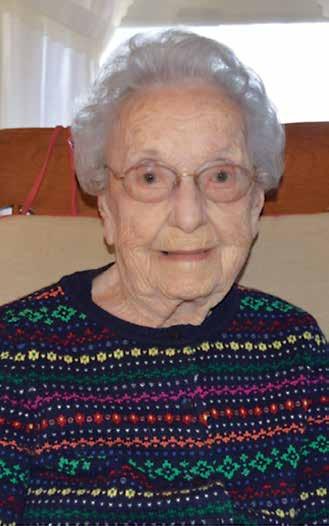
Pistenma’s claim to fame lies in her uncanny ability to recall not just every former student but also where they sat in her classroom. Porter, a student and later a colleague of Pistenma’s, also recalled the notebook that her teacher kept in the top drawer of her desk, where she recorded the names of any disobedient students. Eventually Pistenma needed only to crack open the drawer to restore order to an unruly classroom! Here’s to that—and to a happy and healthy 106th.
MAKE PURCHASES WHILE GIVING BACK TO YOUR ALMA MATER! VISIT OUR TRUSTED PARTNER TO APPLY TODAY!


ALUMNI ATHLeTes weeKeND 5K FUN RUN
sUNDAY, sePTeMBeR 27, 2015
ALUMNI ATHLeTes weeKeND GOLF TOURNAMeNT
MONDAY, sePTeMBeR 28, 2015


sATURDAY, MAY 30, 2015


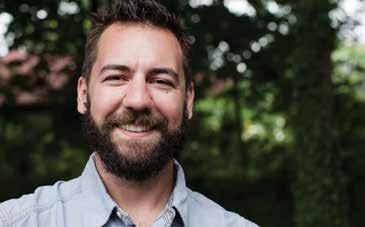
AT A sPeCTACULAR CeLeBRATION OF THe 10,000 R e AsON s CAMPA IGN DURING ALUMNI weeKeND 2015!
7-9 PM
PARTY ON MCKeOwN PLA z A
reaSOn 2 1 0 1
r
“Salem State gave me the confidence to be myself. The music department especially helped me design my major around who I wanted to be and what I wanted to pursue after college, which was songwriting and performing!”
All salem state community members and their families are welcome to mingle and enjoy food, beer, wine, and live entertainment by the Ross Livermore Band. The $30 admission is all-inclusive. Get your tickets online today!
sALeMsTATe.eDU/ALUMNIweeKeND

More than 20 groups are hosting pre-party receptions around campus. Find yours online today!


ALUMNI weeKeND
MAY 28–31

International Alumni Reunion
student Leaders Reunion
Nurses of the 70s Reunion
Class of 2010 Five-Year Reunion
Class of 1965 50th Reunion
Class of 1960 55th Reunion
Viking Pride Celebration
Veteran Alumni and Friends Reunion
50th Reunion society Celebration
Alumni Day of service
… and much more!
NORTH sHORe PRIDe PARADe AND ReCePTION
sATURDAY, JUNe 20
ATHLeTes weeKeND
sePTeMBeR 26–28
Alumni Games
5K Fun Run
Alumni Athletes Golf Tournament at Kernwood Country Club
Keep your calendar up to date! salemstate.edu/alumni/events

L AURA s w AN s ON has been promoted to executive director of the Enterprise Center at Salem State University. She has previously served as a Salem Parks and Recreation commissioner and has sat on boards for Salem Access Television, the Salem Harbor CDC and the Community Affairs and Health Access Committee of North Shore Medical Center, among others. She served as a Salem city councilor from 1999 to 2003.
Re B e CCA D UDA ’04, ’10G, ’12G , a social studies teacher at Richardson Middle School in Dracut, Mass., published her second book, Legendary Locals of Dracut, in December. The proceeds from her first book, Dracut Revisited , were donated to the Dracut Scholarship Foundation. In November, Duda was named Educator of the Year as part of Enterprise Bank’s annual Celebration of Excellence. In accepting the award, she said, “I believe in public education and what I can do to effect change in the world. There is no greater calling in life than being a teacher.”

Lee-A NN eVAN s of Melrose married Brian L’Heureux on April 11, 2015. Lee-Ann joined Massachusetts General Hospital as a registered nurse in February 2015.

C ATH e RIN e
L ATHAM has been promoted to managing director at CBIZ Tofias, where she was previously a director/shareholder. She is also an adjunct faculty member within Salem State’s Bertolon School of Business.

R AMONA B ARR has recently been promoted to bid room manager for the Massachusetts Division of Capital Asset Management & Maintenance (DCAMM). This position is charged with managing all major public building construction procurements and bids for state buildings.
sT e PHANI e B UCK began a new job at EBSCO Information Services (EIS) as a collection management specialist in July 2014.

As HL e Y G OOKIN is engaged to Darby Attridge. The wedding is set for late fall 2015.
L ANC e eATON and Christine Gillis were married on October 12, 2014, at the Floral Showhouse at Niagara Falls in Ontario, Canada.

C H e RYL L. P OPP e ’01G was sworn in as superintendent of Chelsea Soldiers’ Home on November 6, 2014, becoming the first woman to hold the job in the home’s 132-year history. She works with residents and employees to enhance veteran services. She retired from the Massachusetts National Guard in 2008 with the rank of colonel after 30 years.
sANDRA C OOK ’04G and Brian Schultz were married November 1, 2014, at The Tirrell Room, Quincy, Mass., with Justice of the Peace Thomas Welch officiating.
K ATINA Ve L e NT z A s ’14G is a pre-doctoral candidate in the higher education administration program out of the George Washington University Graduate School of Education and Human Development. A graduate assistant for Dr. Daniel Klasik, she is currently working on research about CTE in the European Union and community college remediation.
Congratulations to A NDR e A P ARADI s and Gavin Walsh ’07, who became engaged on New Year’s Eve!

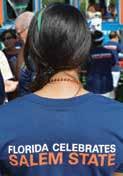
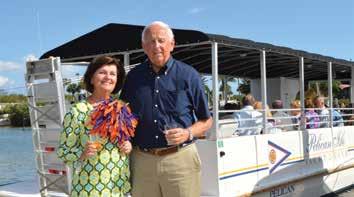

The alumni association’s annual pilgrimage to the Sunshine State this year included a reception for Sullivan and Crosby Society members hosted by Tom ’65 and Pat Grady Marmen ’66, ’69G; a 10,000 Reasons-themed cocktail party hosted by Joanne ’68 and Phil Ricciardiello; and of course a march in the Naples St. Patrick’s Day Parade, where the Salem State contingent, complete with three-piece Irish folk band, was once again the largest presence in the whole event! Keep an eye out for scheduling and details of next year’s trip, already in the works.

OBITUARI es from October 15, 2014 to March 1, 2015
John Malcolm Donaldson, a former professor and mentor at Salem State, passed away in November 2014. He was 80 years old. John attended Hamilton High School and subsequently graduated from the Lenox School in Lenox. He received a bachelor’s degree in history from Tufts University in 1955 and was drafted into the army in 1956. He later continued his studies at Boston University and joined the faculty of Salem State College in 1966 as a member of the history department. In addition to his teaching duties, John was an active mentor to the Salem State sports program. He retired in 1997.
Retired security guard Roger J. LeClerc, 79, formerly of Salem and Georgetown, died in February 2015, at the Twin Oaks Nursing Center in Danvers following a long illness. Born and raised in Salem, he worked with his father and brother in the running of two family businesses, the Les Canadian Cafe, of which he became the owner, and LeClerc Oil & Heating Company, which his late brother, Robert, owned. Roger also worked in security for Salem State, retiring in 1998 after 25 years with the university.
Gilbert G. Higley, 68, of Salem, passed away in February, 2015 at Salem Hospital. Raised and educated in Salem, he was a graduate of Salem High School, class of 1965. He served his country as a member of the United States Army during the Vietnam War and later held numerous positions in the civil service field, building his successful career for over 25 years. He worked concurrently with the Hamilton Police Department as an auxiliary patrolman, with Salem State University as a campus police officer, and with the Marblehead Police Department as a reserve patrolman.
Edward Meagher, a philosophy professor at Salem State from1969 to 1997, passed away in October 2014. Ed joined the philosophy department as an assistant professor and retired as professor emeritus in 1997. A valuable and respected member of the college community, Ed was a member of the faculty senate executive board. He was instrumental in the development of the Salem State Open College project, helped create the philosophy minor and was the advisor to The Salem State Log and Mass P.I.R.G. He founded the Peace Institute in 1982 and represented Salem State at the Massachusetts State College System’s Collaborative for Project Renewal. He became chairperson of the philosophy department and was the president of the Massachusetts State College Association.
Joseph “Joe” Piemonte died peacefully at his Salem home in January 2015, at the age of 91. Raised and educated in Salem, he was a World War II Army Air Force service member based in England. Upon his return from service, he attended Northeastern University and earned a master’s degree in history from Boston University, graduating in 1952. Joe was a member of the Salem Police Department as a reserve officer from 1949 until 1954. He began his career as an educator in Nokesville, Virginia, before joining the faculty at Salem State in 1956, where he taught world history until retiring in 1986. He was an extraordinary teacher who was beloved by generations of students for his ability to make history come to life. A dedicated educator beyond the traditional classroom, Joe was a founding member of the Explorers Lifelong Learning Institute, initially affiliated with Road Scholar (formerly Elderhostel), and today part of Salem State University.
Marvin Lee Roberts, 66, of Gloucester, passed away in September 2014. He spent 15 years at Salem State University where he taught biology and botany. Marvin had many publications in his field. He also spent many summers as a visiting professor at Stone Lab on Lake Erie which was an Ohio State University teaching and research lab. He enjoyed gardening and supplying neighbors and friends with exotic fresh vegetables and fruits.
Thomas Harry Robinson died peacefully at his home in Georgia in August 2014. Born in Lynn, he is remembered as being fun loving and gregarious. He was a diehard Boston sports fan, even while living in the south. He spent many years in the food service industry at Salem State and at Beverly Hospital.
George Nelson Torrey, a resident of Ocala, Florida, and formerly longtime of Melrose, passed away peacefully at home in October 2014 at age 85. Raised and educated in Maine, he served his country proudly as a member of the U.S. Army during the Korean War. A career professor, George received his bachelor’s and master’s degrees from Suffolk University and his doctorate in education from Boston University. He was a recognized professor of English at Salem State for 38 years, retiring in 2000. As a pioneer in the use of instructional media as a tool in the classroom, he was well known throughout the educational world for utilizing technology and media for an improved learning experience. Over the course of nearly four decades, he had a lasting impact on many of his students at Salem State. In addition to the positive changes he made in education, George was active in the Melrose community through the Beethoven Society, the Melrose Senior Chorus and as a writer for the Melrose Mirror
Hazel Mosse eade ’35
Rena Branin Pedroni ’40
Kathryn Callahan s weeney ’40
Louise Figueiredo Ricciardello ’42
Lucy Dumanian Dulgarian ’43
Anna Paoli ’44
Joseph Ferry ’45
Catherine Pasternak w illiams ’45
e lizabeth Garrity O’Neill ’47
Mildred Gould smallwood ’47

e lizabeth Coskery Jaques ’48
Dorothea Macero Lombardi ’49
Kathryn McManus Gainey ’50
Robert Beaulieu ’51
Robert Jalbert ’51
Lucille McCarron Berard ’51
Arlene McDonald Lynch ’51
sheldon Greenglass ’52
Thespina Trearchis Triantafilou ’52
eva DiFilippo ’53
Ann Leverone Gates ’53
Mary Bashford McMurrer ’54
Alice Heffernan sullivan ’54
Gertrude Flynn O’Brien ’55
Jaqueline shane Feeney ’55
Frank Adorn ’56
Ronald Fabiszewski ’58G
David O’sullivan ’59
w illiam Russell ’59G
Peter Arslanian ’60
Joan Hunt Murtagh ’60
Melvin Baran ’61
sabatino Bolognese ’61
John O’Brien ’61
Mariann zensen Aiello ’62
Mary Burdett ’62G
Russell Goodwin ’64
Julie Fleming ’65
Peter symonds ’65
Margaret Curley Herrick ’66G
Rachel Lynge watkins ’69G
Rita Grillo Towne ’70
Margaret s t. Amand Macedo ’70
Margaret-Helen wood Jones ’70
Alvin Huebner ’70G
Phyllis Parker simpson ’70G
Daniel Hourihan ’71
Joan Reynolds ’71
David w inters ’71
Billie Ferrick Gorski ’72
David Robbins ’72
Michael Murray ’72G
Linda Pelletier ’74
Patricia Kohanski shea ’75G
Richard Rafuse ’75G
Richard sciacca ’76
Janet Kunsman ’77
A. Cesati ’78
Peter Mitchell ’78
Ann Nagelschmidt ’79
Kathleen shortill Connolly ’79G
George w hite ’81
John Gentleman ’82
Jeannette Nordin s wain ’82G
Paul Vacca ’85
Rocco Jesso ’85G
Marilyn Morley Rossetti ’87
eugene salem ’87H
Joanne Lambert ’88G
Maureen Betz egan ’91
samar Alsarabi ’91G
Joanne Laubner Davis ’93G
Mary Drucker ’94
Patricia Power DeConinck ’95G
Kathy Brown Bennett ’99
Maureen Hanna ’02G
Cheryl sidelinker Cox ’02G
James sinagra ’03G
Margaret Tarr ’12
Nicole Heck Bairos ’13
Yennifer De La Cruz ’14
’10
On November 8, 2014, K YL e Me ADO ws and Ryan Nicole Greelish exchanged vows in Smithfield, RI. Congratulations to the newlyweds!
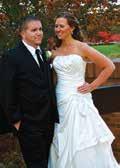
He ATH e R sYLVIA and her fiancé Josh welcomed their daughter Harper Souza into the world on September 8, 2014! Congratulations to the happy family.

wILLIAM wARD started his MBA at Babson’s San Francisco campus and expects to finish in 2016. He currently works as a technology manager at Standish Management in San Francisco.
M IRL es NA Az OR married Samy M. Sterlin on November 14, 2014, and they are excited to spend their future together. Mirlesna has been working as a community director at the University of North Carolina–Asheville since her graduation.

D ON M ACHARIA started his career at Lifecare of Acton in June 2013. He also does per diem work for Avenue Homecare a few weekends a month. Don is on the Massachusetts Association of Registered Nurses (MARN) board of directors.

sALeM sTATe UNIVeRsITY ALUMNI AssOCIATION
BOARD OF DIReCTORs
president
Pamela Doherty ’92
vice president
Stephanie Magdis ’06G
secretary
Joseph Wamness ’00G
historian
Marilyn Flaherty ’54
Folk singer M OLLY P INTO M ADIGAN released her second album, Wildwood Bride, on March 19; it was recorded at Dirt Floor Recording Studio in Connecticut. Winner of Boston Folk Festival’s songwriter contest and a dual creativity award recipient at Salem State, Molly is a fixture on the regional music scene and recently has been featured on WBRS and WUMB.

B RIAN K IBL e R is completing a year of service with AmeriCorps as a volunteer outreach coordinator at Social Capital, Inc. in Woburn. One highlight of his service includes organizing WorldFest, a multicultural festival that celebrates world cultures.
Congratulations to Je NNIF e R Ye RDON ’14G , who married Mark Bolton this February in Newport, RI, where the couple met. Jennifer is a social worker at DOVE, a domestic agency in Quincy.
trustee
Alyce Davis ’75
members at large
Robert Callahan ’72
Dr. Erik Champy ’89, ’94G
Eileen Connolly ’59, ’77G
Major TJ Cullinane ’86
Christopher Corrente ’10, ’12G
Richard Durgan ’69
l ance Eaton ’01
Dorothy Foley ’48
Anthony Guerriero ’92
Dr. Judith Josephs ’63, ’65G
Josephine Kennedy ’72, ’76G
Patricia libby ’71
Andrea liftman ’75G
Frank lillo ’64, ’69G
Keila lora ’13
Deana Manfra ’11
Dexter McKenzie ’95
Professor Jane Moroney ’60, ’62
Dr. Jo-Anne Murphy ’77G
Melissa Ogden ’00
Thomas Page ’75, ’76G
Gary Roach ’80
Frederick Sannella ’64
Deirdre Sartorelli ’83
Debra l ee Surface ’05
Carol vara ’85, ’92G
Alfred v iselli ’59, ’64G
Mikki Wilson ’09
regional member
Ms. Carol vara ’85, ’92G
student trustee
Michael Crawford ’15
When I finished my tour of duty in Afghanistan, I came back home to lynn, Massachusetts, and I did what I believe most veterans do: I became a recluse. I felt as though no one understood the gravity of the transition I was going through, so I never reached out. The isolation took a significant toll on me. I just hoped that in due time I would find normalcy in my new surroundings and be able to begin anew.

It took a while to acclimate to my new civilian life, but eventually I decided to take a chance and move forward with my plan to apply to college. Salem State had been on my list as I was graduating from high school. Now several years—and what seemed like several lifetimes—later, I realized it still had everything I wanted. The decision to apply here was suddenly an easy one.
On campus in Salem, I slowly but surely defected from my hermit status. Becoming a full-fledged member of the university community didn’t happen on its own. It took the love, help and support of my peers, my professors and many others—people like veterans advisor Melissa Thayer and my vA work-study supervisor Ted Serozynsky. They made it all happen for me, and I couldn’t appreciate them more for it.
Now here I am in Florida speaking on behalf of every current student to a group of Salem State’s most dedicated alumni. That’s a long, long way from my bedroom in lynn.
I don’t know if anyone realizes just how much new life Salem State breathed into me. I wonder how many donors to the 10,000 Reasons campaign really understand that they, too, are breathing life into current and future students. I want you all to know that by supporting something as simple an an internship program or the veterans center, you do breathe life into students. Thousands of them. Just like me.
This school and this campaign made me feel like an intrinsic part of a community instead of just a nameless face. Now there’s nothing I want more than to see the dreams, hopes and visions of other students met as mine have been. With everyone’s support, I know it’s possible.
What’s your reason?
salemstate.edu/reasons
# ssUReasons
